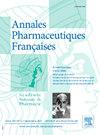Study of the toxicity of the essential oil of Brocchia cinerea
IF 1.1
Q4 PHARMACOLOGY & PHARMACY
引用次数: 0
Abstract
Brocchia cinerea is a North African plant belonging to the Asteraceae family, widely utilized in Algerian folk medicine to treat a variety of illnesses. These therapeutic virtues are mainly due to the plant essential oil. The chemical components of this oil were identified using GC-MS, and the variability in these components’ levels was examined in nine samples that were taken at different times from two locations in Algeria's northern Sahara. The contents of the essential oil were found to consist of eight components, varying in concentrations: beta-thujone (46.80%), 1-Methyl-2-(1’ methylethenyl) -3’- ethenylcyclopropylmethanol (14.59%), 1,8-Cineole (12.63%), limonen-10-ol (9.47%), 1(7),3,8 o Menthatriene (3.45%), and (-)-Camphor (2.11%). Toxicity studies were conducted in order to assess the safety of the essential oil, namely: LD50 estimation and biochemical blood parameters evaluation. The results showed an LD 50 of 507.5 mg/kg close to the LD50 of Beta-thujone (442 mg/kg): the main component of the essential oil, making it accountable for the major toxicity. The apparition of seizures as toxic manifestations for higher concentrations confirmed that. The essential oil of Brocchia was noted to be classified as slightly, weakly toxic, and the Beta-thujone contents showed to be within the regulatory accepted values, which makes the use of Brocchia safe within the indicated standards.
La Brocchia cinerea est une plante nord-africaine appartenant à la famille des Astéracées, largement utilisée dans la médecine populaire algérienne pour traiter diverses maladies. Ces vertus thérapeutiques sont principalement dues à l’huile essentielle végétale. Les composants chimiques de l’huile essentielle ont été identifiés par GC-MS, et la variabilité des niveaux de ces composants a été examinée dans neuf échantillons prélevés à des moments différents dans deux endroits du nord du Sahara algérien. Le contenu de l’huile essentielle s’est avéré être constitué de huit composants, dont les concentrations varient: bêta-thuyone (46,80 %), 1-méthyl-2-(1’ méthyléthényl)-3’- éthénylcyclopropylméthanol (14,59 %), 1,8 -Cinéole. (12,63 %), limonène-10-ol (9,47 %), 1(7), 3,8 o Menthatriène (3,45 %) et (-)-Camphre (2,11 %). Des études de toxicité ont été menées afin d’évaluer la sécurité de l’huile essentielle, à savoir: estimation de la DL50 et évaluation des paramètres biochimiques sanguins. Les résultats ont montré une DL 50 de 507,5 mg/kg proche de la DL50 de la Bêta-thuyone (442 mg/kg): composant principal de l’huile essentielle, ce qui le rend responsable de la majeure toxicité de la plante. L’apparition de convulsions comme manifestations toxiques à des concentrations plus élevées le confirme. L’huile essentielle de Brocchia a été classée comme légèrement, faiblement toxique, et la teneur en bêta-thuyone s’est avérée conforme aux valeurs réglementaires acceptées, ce qui rend l’utilisation de Brocchia sûre dans le cadre des normes indiquées.
雏菊精油的毒性研究。
Brocchia cinerea 是一种属于菊科的北非植物,在阿尔及利亚民间医学中被广泛用于治疗各种疾病。这些治疗功效主要归功于植物精油。我们使用气相色谱-质谱(GC-MS)对这种精油的化学成分进行了鉴定,并在阿尔及利亚撒哈拉沙漠北部两个地方不同时间采集的九个样本中研究了这些成分含量的变化。研究发现,精油中含有八种不同浓度的成分:β-�侧酮(46.80%)、1-甲基-2-(1'甲基乙烯基)-3'-乙烯基环丙基甲醇(14.59%)、1,8-噌烯(12.63%)、柠檬烯-10-醇(9.47%)、1(7),3,8 邻薄荷三烯(3.45%)和 (-)- 樟脑(2.11%)。为了评估精油的安全性,我们进行了毒性研究,即半数致死剂量估计和血液生化参数评估。结果显示,LD50 为 507.5 毫克/千克,接近精油主要成分 Beta-Thujone 的 LD50(442 毫克/千克),因此它是主要的毒性成分。更高浓度的毒性表现为癫痫发作,这也证实了这一点。人们注意到,肉桂精油被归类为轻微、弱毒性,而 Beta-Thujone 的含量显示在监管机构认可的值范围内,这使得肉桂的使用在指定标准内是安全的。
本文章由计算机程序翻译,如有差异,请以英文原文为准。
求助全文
约1分钟内获得全文
求助全文
来源期刊

Annales pharmaceutiques francaises
PHARMACOLOGY & PHARMACY-
CiteScore
1.70
自引率
7.70%
发文量
98
期刊介绍:
This journal proposes a scientific information validated and indexed to be informed about the last research works in all the domains interesting the pharmacy. The original works, general reviews, the focusing, the brief notes, subjected by the best academics and the professionals, propose a synthetic approach of the last progress accomplished in the concerned sectors. The thematic Sessions and the – life of the Academy – resume the communications which, presented in front of the national Academy of pharmacy, are in the heart of the current events.
 求助内容:
求助内容: 应助结果提醒方式:
应助结果提醒方式:


